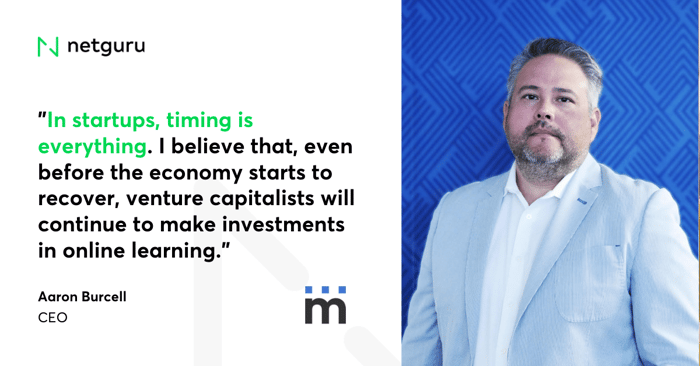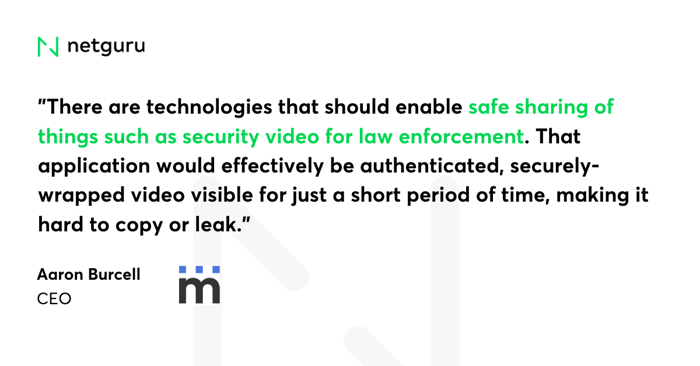Why Many Industries Have No Choice But to Incorporate Video Conferencing

Tomasz Stolarczyk: What is the future of video conferencing?
Aaron Burcell: Over the next three years, Video Conferencing is going to be a huge opportunity, where brands emerge with specific-purpose apps. Just one example, methinks, which is a platform dedicated to the market research industry, was already filling a need for faster, more efficient and convenient customer insights - now is seeing an up-tick in technology licensing and API interest for all sorts of video interviewing use cases. Setting aside methinks, new video-oriented apps specific to the purpose and the intent of the customer will emerge and become very successful. And, businesses will be willing to pay for it.
Coming back to methinks, we have a whole bunch of very specific features that help researchers, designers, product managers and marketers gain customer insights. And, at our core, our video and audio quality are outstanding. Today, and in the future, every premium video product company will focus on solving issues of scale that degrade the quality of app UX. I expect that companies like Zoom will start to acquire applications for productivity and then incorporate video conferencing into them. This is a good thing, because video platform valuations will start to reflect the growth in specific industries, rather than an untethered, more speculative valuation predicated on video conferencing adoption in business and consumer markets.
TS: And what about the market? How do they react to it?
AB: Market research has no choice but to incorporate video conferencing. Qualitative research typically has been done in person in usability labs or coffee shops during one-on-one meetings or in focus groups – that’s all moving online. It has to, right?
.png?width=700&name=Aaron%20on%20research%20(1).png)
So, all tech and platform companies will cater to the customer’s needs. And the customer needs the ability to conduct qualitative research online. And, because research firms and consultants are pivoting to remote video research solutions, it is very unlikely that the industry will return to in-person research.
TS: What are the top 3 areas where video conferencing might help the most?
AB: The first high-profile area of impact is distance learning. There are a lot of industries where video learning platforms have tried and failed historically. Especially in education. But, in the wake of Covid-19, I expect that distance learning platforms will be much more successful in the future.

I have already seen this. Startup investments in distance learning are happening very quickly and, soon, new and revamped distance learning initiatives from the Big Five will be revealed. It’s a little shocking because, like other video-industry vets, I’d thought video distance learning was fairly well consolidated, especially after Linkedin purchased Lynda.com for $1.5bn in 2016. But, I guess none of us factored for distance learning in a pandemic.
There are companies that are looking at distance-learning in a broader context. Focusing on different skills, making it about hobbies. Learning how to cook, photograph, and that kind of stuff. I think where distance learning gets really interesting is in companies building video conferencing platforms instead of just video streamed to players for learning. And I know for a fact that’s happening now. I am seeing the investment flow.
Secondarily human capital - Internal and external reviews - will be a high-impact area of video conferencing. We’ve been contacted by a number of companies to do an internal audit of employees. Existing video-conferencing companies have been focused on broad presentation features to meet sales and basic communications requirements, but I think that when the economy re-opens, we will see more and more focus on companies auditing their employees to understand how to move forward with remote work and distance learning. There is a need for HR people to interview employees to discover how to retain them - those interviews need video recording, editing, transcription, observers, etc. Longer-term, they’ll incorporate voice tone, inflection, hand gesture and faction expression analysis - human filtering and AI-based analysis. HR people will need to conduct all sorts of conversations about compensation, benefits and how life changes in the aftermath of COVID-19. I think this is a big area of growth for video conferencing.
Finally, video conferencing helps the global economy growth through transcription and translation. This is a massive area for growth. We have a lot of multinational customers at methinks. Our customer base started with some Korean companies such as Samsung, LG, Hyundai, or Bank of Korea. They were looking to launch products in different geographies – Taiwan, Japan, the US. A huge part of product validation research for multinationals is localization and transcription services. We partnered with transcription companies for human translation, but we also were the first company in research to use transcription products from both IBM and Google to provide a superior transcription service. And, I think that this is an area in broader video conferencing that can – and needs to – be improved significantly.
About a year ago, when I joined the company and looked at the product, the founders and I reviewed all of the challenges in trying to incorporate video chat into other products. Our founders helped me understand that most video chat features in apps are based on WebRTC, which is an old standard. What I realised when looking around for better products is that everybody who is building new video conferencing technologies takes the WebRTC stack and makes improvements specific to their customer needs. But, transcription will be a universal business need before long. Eventually, this universal need will be addressed at the WRTC stack level, or a newer, better standard will emerge.
TS: Except those 3, are there any other areas worth mentioning?
AB: There are. It’s also worth mentioning legal applications.

The video could be disabled, clipped and, or stitched, updated remotely and eventually removed. This will enable digitizing things like terrorist hunting or security protocol for the airports.
Another area that is going to grow with the use of video conferencing are depositions. The legal system in the US is at a place where the number of cases is overcrowding prisons and interfering with civil rights. This will eventually have to bend towards video-conferencing too. The pressure on the judicial system combined with insufficient numbers of judges, courtrooms, public defenders creates this really interesting situation where video conferencing is going to be used not just for depositions, where you’re taking testimony or interviewing people, but potentially used by law enforcement for investigations as well.
Investigators won’t have to travel and spend all day interviewing just one person. They will be able to investigate from their desktop. I think all that will move online along with the process of arbitrations. But in order to do that, you have to have really good transcription capabilities. You need to be able to review and revise documents securely, remove them before someone does a screen capture or records a conversation. These are security measures that we already have at methinks, so it’s only a matter of time before they are mimicked or borrowed in the legal applications. It may take awhile, but I know it is coming.
TS: What about using it in the sales department?
AB: Great idea. There is a tool that analyzes video conferences and, with facial recognition, it evaluates facial reactions and tone of voice to determine how effective a sales pitch was – helping people understand how they can get better and improve their professional skills. It’s a tremendously powerful tool that has a direct effect on the future revenue stream of a company that uses it. That’s a fascinating way of using AI in video conferencing. Utilizing AI is in our roadmap. We will eventually get to the place where customers can create unmoderated user testing that creates insights for products based on AI analysis. I think other applications of Machine Learning are going to focus, again, in Human Resources and Talent Recruitment interviewing. But, beyond hiring, auditing and promotions - use cases like security clearance for government, security interviews for passports or for government jobs – all sorts of purposes where the authentication is a huge requirement. That is going to be a huge area of growth in enterprise video conferencing.
TS: What is the main target group for video conferencing?
AB: Currently, tools like Zoom are used mostly by businesses, not consumers. Consumers are using Zoom to have happy hours, family meetings and connect during COVID-19. But, consumers don’t find video conferencing particularly easy to use and there is a lot of coaching required. It’s challenging for consumers and I think it can be made a lot easier. There are companies that are very good at figuring out how to help mass market consumers understand video and communication -- companies like Twitch and Youtube. They will likely help bring consumer video conferencing use to another level.
TS: Have you noticed any new trends that started during the pandemic caused by COVID-19?
AB: For us, the challenge wasn’t about optimisation but about improving the video and audio quality. It took about 6 months to create our own custom stack, and a lot of companies are going through that too. Right now, when funding is low, a lot of them are taking the opportunity to reduce the marketing spend, reduce the employee headcount, and focus on building better products and engineering. It’s because investor expectations have changed from grow your business to survive and improve your technology.
I think this strategy is going to build a whole new, better class of products in video conferencing. Video chat will be the new core component of communications and revenues in business. I am taking the opportunity to talk to a lot of new customers and understand what features and functionalities they want, but at the same time I’m in touch with our competitors and other startups in our space, trying to understand what lies ahead. I think that, particularly in Silicon Valley, there is an attitude that, as a category, startups can all respond to those market changes together. So it's really important to understand the expertise of the competitors in your space because partnerships, M&A accelerate industry growth.
In the case of methinks, we treat the COVID-19 situation as a tremendous learning experience. We have benefited in the context of having a platform already patronized by large customers. But our customer type has changed more than losing startup customer revenues. We are seeing a lot of independent researchers wanting to work with us. And with all the challenges that people are currently facing, working with professional researchers helps improve our product. We also learned that mobile platforms have limitations. The default settings in platforms require some education for self-serve customers and the interviewee. Even from the hardware point of view, we learned that some mobile phones are too old or have insufficient memory to handle the video requirements without crashing. But, these are only short-term issues.







